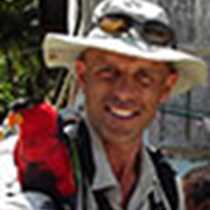Krossfjorden, Spitsbergen
While terms such as dawn have little meaning in the land of the midnight sun, after steaming to the west and south overnight we arrived in Krossfjord and were given an early morning wake up call at the face of the Lilliehook glacier. A disinterested bearded seal lolled on a nearby floe while a small iceberg rolled and disintegrated beside the ship.
Appropriately, we chose our destination for the morning activities to be the Julibreen – named for the French national day, July 14. Zodiacs and kayaks were launched and hikes of varying lengths were planned.
We have become used to a landscape of blues and whites in the ice, browns and greys onshore and patches of purple on the tundra. Today we saw drifts of verdant vegetation and splashes of orange lichen along the walls of the fjords. Closer inspection onshore revealed a seabird city on the cliffs high above the fjord. Thousands of black-legged kittiwakes and Brünnich’s guillemots crowded the ledges, while Northern fulmars and glaucous gulls cruised the cliffs.
The seabirds are transferring nutrients from the marine to terrestrial environment. The steady rain of guano from the cliffs fertilizes the otherwise nutrient-poor soils of the lateral moraine, promoting lush plant growth by Arctic standards. Dominating this plant community are two species with one important feature in common. Both scurvy-grass (which is not a grass) and mountain sorrel are a rich source of vitamin C, a fact which did not go unnoticed by vitamin deficient early whalers and other mariners visiting this region. A diverse community of high Arctic flora was also present, dominated by saxifrages of which the tufted saxifrage (pictured) was commonest. The rich plant growth also attracts grazing animals such as reindeer and pink-footed and barnacle geese. This abundance of life also attracts a range of predators and scavengers and today we were rewarded with great views of an Arctic fox along the shoreline.
In the afternoon we were at sea steaming south through glassy seas with a programme of presentations and whale-watching. The latter proved profitable, with excellent views of both humpback and fin whales. Tomorrow we will reach pack ice; another day of exploration awaits.
While terms such as dawn have little meaning in the land of the midnight sun, after steaming to the west and south overnight we arrived in Krossfjord and were given an early morning wake up call at the face of the Lilliehook glacier. A disinterested bearded seal lolled on a nearby floe while a small iceberg rolled and disintegrated beside the ship.
Appropriately, we chose our destination for the morning activities to be the Julibreen – named for the French national day, July 14. Zodiacs and kayaks were launched and hikes of varying lengths were planned.
We have become used to a landscape of blues and whites in the ice, browns and greys onshore and patches of purple on the tundra. Today we saw drifts of verdant vegetation and splashes of orange lichen along the walls of the fjords. Closer inspection onshore revealed a seabird city on the cliffs high above the fjord. Thousands of black-legged kittiwakes and Brünnich’s guillemots crowded the ledges, while Northern fulmars and glaucous gulls cruised the cliffs.
The seabirds are transferring nutrients from the marine to terrestrial environment. The steady rain of guano from the cliffs fertilizes the otherwise nutrient-poor soils of the lateral moraine, promoting lush plant growth by Arctic standards. Dominating this plant community are two species with one important feature in common. Both scurvy-grass (which is not a grass) and mountain sorrel are a rich source of vitamin C, a fact which did not go unnoticed by vitamin deficient early whalers and other mariners visiting this region. A diverse community of high Arctic flora was also present, dominated by saxifrages of which the tufted saxifrage (pictured) was commonest. The rich plant growth also attracts grazing animals such as reindeer and pink-footed and barnacle geese. This abundance of life also attracts a range of predators and scavengers and today we were rewarded with great views of an Arctic fox along the shoreline.
In the afternoon we were at sea steaming south through glassy seas with a programme of presentations and whale-watching. The latter proved profitable, with excellent views of both humpback and fin whales. Tomorrow we will reach pack ice; another day of exploration awaits.




